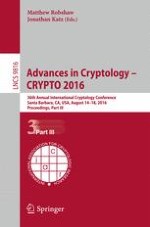2016 | OriginalPaper | Buchkapitel
Rate-1, Linear Time and Additively Homomorphic UC Commitments
verfasst von : Ignacio Cascudo, Ivan Damgård, Bernardo David, Nico Döttling, Jesper Buus Nielsen
Erschienen in: Advances in Cryptology – CRYPTO 2016
Verlag: Springer Berlin Heidelberg
Aktivieren Sie unsere intelligente Suche, um passende Fachinhalte oder Patente zu finden.
Wählen Sie Textabschnitte aus um mit Künstlicher Intelligenz passenden Patente zu finden. powered by
Markieren Sie Textabschnitte, um KI-gestützt weitere passende Inhalte zu finden. powered by
